Are you a Quiet Speculation member?
If not, now is a perfect time to join up! Our powerful tools, breaking-news analysis, and exclusive Discord channel will make sure you stay up to date and ahead of the curve.
In between acing some online leagues with Ad Nauseam and running into back-to-back Infect rounds in others, I've been watching and playing more Legacy than usual. Last weekend's Grand Prix Prague and Columbus led to such an uptick in Legacy coverage that I couldn't help it. How else am I supposed to get value out of my old Dredge and Ad Nauseam Tendrils decks? Also, is anyone really surprised I'd be playing Ad Nauseam in Legacy given my Modern preferences? Speaking of which, I loved watching Rodrigo Togores take down Prague with the newest iteration of Legacy Storm, proud to see the Modern Ad Nauseam pilot (Togores is a frequent contributor to the deck's MTGSalvation thread) get the win. Don't worry---I'm not jumping ship to a format held hostage by the Reserved List. Even so, all that Legacy did get me wondering: could we apply Legacy principles, tech, and cards to our beloved Modern?
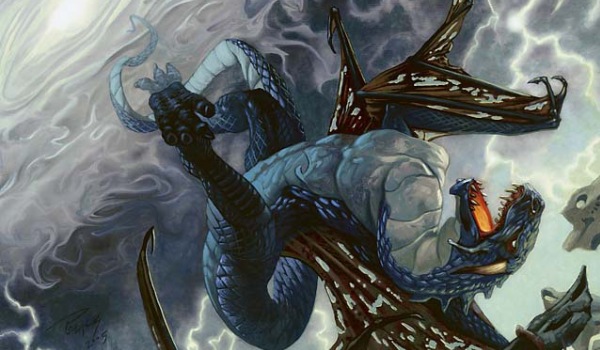
Modern obviously lacks defining Legacy staples like Force of Will, Brainstorm, Wasteland, Ancient Tomb, Cabal Therapy, and others. We've also determined that some otherwise acceptable Legacy cards are way outside acceptable Modern power levels: Deathrite Shaman, Jace, the Mind Sculptor, and Dark Depths come to mind. These obvious differences aside, Legacy strategies and games do contain numerous cards that are legal in Modern, whether sluggers like Tarmogoyf and Delver of Secrets // Delver of Secrets or support cards like Lightning Bolt and Aether Vial. Modern also contains possible analogs to Legacy mainstays, such as Disrupting Shoal versus Force of Will. Today, I want to analyze a few such Legacy cards and concepts to see if they can find homes in Modern. I also promise this sentence is the last you'll hear of Ad Nauseam for the day.
[wp_ad_camp_1]
Young Pyromancer
Jordan, our resident tempo specialist, has already documented some of his attempts to get Young Pyromancer working in Modern. Unfortunately for Jordan and his Mandrills, the Shaman has historically struggled to stay relevant in a format both clogged with removal and without free countermagic like Force and Daze as protection.
 This is in sharp contrast to Legacy where Pyromancer and, to a lesser extent, his bigger white brother Monastery Mentor have solidified their status as top-tier players. Take Noah Walker's and Alexander Hayne's 3rd and 4th place Grixis Delver lists at Columbus and Prague respectively, or Grixis Delver's top positioning in Columbus's and Prague's Day 2 standings. Cheap cantrips and free countermagic are plentiful in Legacy, along with busted Pyromancer synergies like the hallmark Gitaxian Probe/Cabal Therapy combo. The Elemental tokens can also have a higher impact in a generally slower, more interactive format. Add in Legacy's relative lack of removal, certainly as compared with Modern, and it's not hard to see why Pyromancer shines in one format and wallows on the fringe in the other.
This is in sharp contrast to Legacy where Pyromancer and, to a lesser extent, his bigger white brother Monastery Mentor have solidified their status as top-tier players. Take Noah Walker's and Alexander Hayne's 3rd and 4th place Grixis Delver lists at Columbus and Prague respectively, or Grixis Delver's top positioning in Columbus's and Prague's Day 2 standings. Cheap cantrips and free countermagic are plentiful in Legacy, along with busted Pyromancer synergies like the hallmark Gitaxian Probe/Cabal Therapy combo. The Elemental tokens can also have a higher impact in a generally slower, more interactive format. Add in Legacy's relative lack of removal, certainly as compared with Modern, and it's not hard to see why Pyromancer shines in one format and wallows on the fringe in the other.
Legacy fans and diehards needed no introduction to Pyromancer, but the above discussion helps orient Moderners and newer players to the creature's impressive pedigree. To be fair, many Modern regulars have probably seen the infamous 1/1 Elementals in action before. Examples range from Grixis Delver's prominent finishes from spring 2015 to UR Delver's as recently as April. Mardu has even adopted Red Bob, with Joe Jancuk packing the full Pyro playset en route to his 8th place finish at the mid-April SCG Columbus Classic. Scattered performances aside, Young Pyromancer has not come close to matching his Legacy success in Modern.
We know Modern history hasn't been very kind to the Pyro, but could that change with different deckbuilding approaches?
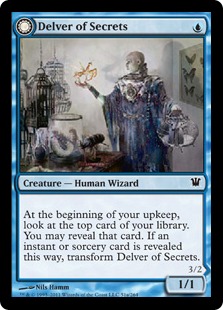 If Pyromancer is to enjoy time in the Modern spotlight, the first thing that needs to change is deckbuilder fixation on directly importing Legacy builds. Especially Delver Legacy builds. Since the post-Eldrazi April metagame has unfolded, Delver decks have been consistently mediocre to terrible. May was no exception, with Grixis Delver not even hitting 1% of the metagame and no other Delver decks appearing at all. In other formats, Delver and Pyromancer fit together like a Kitchen Finks and Melira, Sylvok Outcast in a (Birthing) Pod, but those lessons are being misapplied here because Modern is frequently inhospitable to these cards. Both the theories and the numbers attest to that, and although isolated Delver pilots like Jordan can put up wins, the deck can't currently cut it on a larger scale.
If Pyromancer is to enjoy time in the Modern spotlight, the first thing that needs to change is deckbuilder fixation on directly importing Legacy builds. Especially Delver Legacy builds. Since the post-Eldrazi April metagame has unfolded, Delver decks have been consistently mediocre to terrible. May was no exception, with Grixis Delver not even hitting 1% of the metagame and no other Delver decks appearing at all. In other formats, Delver and Pyromancer fit together like a Kitchen Finks and Melira, Sylvok Outcast in a (Birthing) Pod, but those lessons are being misapplied here because Modern is frequently inhospitable to these cards. Both the theories and the numbers attest to that, and although isolated Delver pilots like Jordan can put up wins, the deck can't currently cut it on a larger scale.
This suggests moving away from the so-called "Delver trap" with Pyromancer and treating the Shaman as a free agent. We could tolerate Modern's abundance of removal, lack of powerful cantrips, and other contextual miscues if we had some decent Force or Daze substitute to fill the gaps. We don't and blue-based Pyromancer is basically off the table because of it. Where do we go instead? I'd start back with Jancuk's Mardu list from SCG Columbus:
Mardu Tempo, Joe Jancuk (8th, SCG Columbus Classic 4/2016)"
Without Force of Will or Daze to protect our Pyromancer and serve as catch-all answers for other threats, Modern players need to turn to a different set of generic solutions. Enter Thoughtseize and Inquisition of Kozilek. Although not the same quality as catch-all staple Force of Will, these cards passably and proactively dispatch Pyromancer removal and opposing win conditions, clearing the way for your Shamans.
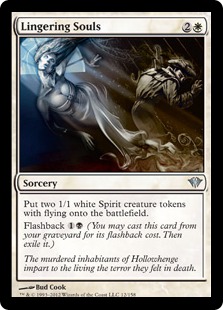 Because both discard spells are black, it's tempting to switch right to Grixis and ditch white entirely. Beware the Delver trap! We move to Mardu over Grixis for two cards. First is Path to Exile, the best catch-all removal spell in Modern (even if not its most versatile, Bolt, which we incidentally also keep). Second, we get Lingering Souls to push our "go wide" angle. This is a huge addition, alleviating the traditional Modern Delver problem of being unable to defend a flipped Insect. The Souls swarm is virtually immune to spot removal and, especially in tandem with Zealous Persecution, can quickly close a game an indefensible Delver would flub.
Because both discard spells are black, it's tempting to switch right to Grixis and ditch white entirely. Beware the Delver trap! We move to Mardu over Grixis for two cards. First is Path to Exile, the best catch-all removal spell in Modern (even if not its most versatile, Bolt, which we incidentally also keep). Second, we get Lingering Souls to push our "go wide" angle. This is a huge addition, alleviating the traditional Modern Delver problem of being unable to defend a flipped Insect. The Souls swarm is virtually immune to spot removal and, especially in tandem with Zealous Persecution, can quickly close a game an indefensible Delver would flub.
Theoretical strengths aside, it's worth noting that Grixis Delver at .9% in May still trounced Mardu's paltry .3%. Does this mean Grixis Delver is the better deck, as my earlier arguments about low percentages may suggest? Not necessarily. Mardu suffers from having no established list and little top-player advocacy. Just check out the muddled 75s in these Mardu standouts from the last few months:
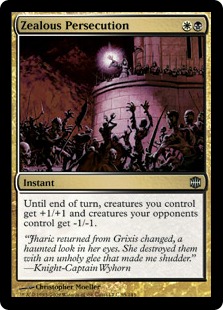 Mardu Tokens, Grant Mitchell (SCG IQ O'Fallon 4/2016)
Mardu Tokens, Grant Mitchell (SCG IQ O'Fallon 4/2016)- Mardu Midrange, Kyle Carruthers (SCG IQ Littleton 4/2016)
- Mardu Midrange, Donovan Lachney (SCG IQ Littleton 3/2016)
- Mardu, Ben Stark (Pro Tour Oath of the Gatewatch 2/2016)
What a mess! Some decks use Exterminate!s and others use planeswakers. Some use Painful Truths and others prefer their (horrible) Soulfire Grand Masters. Until these lists crystallize around a more established core, it's no wonder Mardu lingers beneath Tier 3 in recent metagame updates.
With their current tools, neither Mardu nor Pyromancer are going to be Tier 1 material any time soon. But they could certainly solidify Tier 3 status with intermittent Tier 2 appearances, and I believe further Nahiri, the Harbinger experimentation will be just the thing to get Mardu where it needs to be. The difference between a .3% and a .9% deck is far more surmountable than a .9% deck and a 4% deck, and I fully expect Mardu and Legacy immigrant Young Pyromancer to make it in Modern before the year is out. Just remember: avoid the Delver trap and play to Pyromancer's token generation with synergies like Souls and Persecution.
Free Spells
I spent more time on Pyromancer than I will on these next sections because so many Modern players ask about transferring their Pyro strategies from other formats. That said, there are plenty of Modern players who would forever trade the possibility of a Splinter Twin unban if it meant adding free countermagic such as Force of Will and Daze to the format. Although these cards pose an interesting testing question that could be tackled in a future article, for now it's enough to say these cards aren't legal and we don't have many replacements.
Thankfully, some hidden Modern gems can fill the free spells void, even if they can't supplant Force of Will for its status as the glue that holds Legacy together.
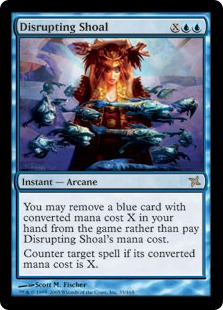 Of course, the most obvious of the bunch is Disrupting Shoal, a card Jordan has written more articles about than I have written metagame updates. I mostly agree with his assessments of Shoal and am consistently surprised to see this card in so few lists. Many Modern decks are hyper-concentrated in the one-mana and two-mana range, and if anything can help make Legacy Delver fanatics live the Modern dream, it's dropping the turn one Wizard with Shoal backup on the play. Despite a plethora of Shoal targets in Affinity, Burn, Infect, Merfolk, Abzan Company, and many other decks, Shoal's mechanical restrictions have justifiably limited its play. Only certain blue-heavy decks can use it to begin with, and an even smaller subset of those decks can benefit from it (i.e. decks that are tapping out early to deploy threats). All of this makes Shoal more roleplayer than definer, although I'll keep looking for this card to make its Grand Prix breakout.
Of course, the most obvious of the bunch is Disrupting Shoal, a card Jordan has written more articles about than I have written metagame updates. I mostly agree with his assessments of Shoal and am consistently surprised to see this card in so few lists. Many Modern decks are hyper-concentrated in the one-mana and two-mana range, and if anything can help make Legacy Delver fanatics live the Modern dream, it's dropping the turn one Wizard with Shoal backup on the play. Despite a plethora of Shoal targets in Affinity, Burn, Infect, Merfolk, Abzan Company, and many other decks, Shoal's mechanical restrictions have justifiably limited its play. Only certain blue-heavy decks can use it to begin with, and an even smaller subset of those decks can benefit from it (i.e. decks that are tapping out early to deploy threats). All of this makes Shoal more roleplayer than definer, although I'll keep looking for this card to make its Grand Prix breakout.
A lesser-known but equally interesting piece of forgotten free technology is Snapback.
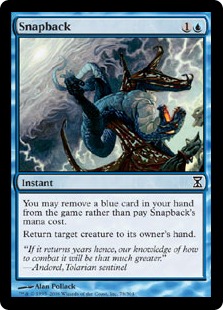 The free Command of Unsummoning from Time Spiral is even more tempo-oriented than Shoal, temporarily removing opposing threats or protecting your own clocks. At least Shoal permanently rids you of a problematic target. Tempo predispositions aside, Snapback has far fewer cost restrictions than Shoal, allowing you to pitch any blue card à la Force of Will. Also unlike Shoal, Snapback deals with a wider range of creature threats in a format defined by creatures. Notable targets include Blinkmoth Nexus in both Affinity and Infect, Tasigur the Golden Fang and Gurmag Angler in Jund, Grixis, and Abzan strategies, and both sides of Kiki Chord's combo. It even disrupts Abzan Company persist loops that sneak through off four-mana Collected Company, an instant Shoal seldom hits.
The free Command of Unsummoning from Time Spiral is even more tempo-oriented than Shoal, temporarily removing opposing threats or protecting your own clocks. At least Shoal permanently rids you of a problematic target. Tempo predispositions aside, Snapback has far fewer cost restrictions than Shoal, allowing you to pitch any blue card à la Force of Will. Also unlike Shoal, Snapback deals with a wider range of creature threats in a format defined by creatures. Notable targets include Blinkmoth Nexus in both Affinity and Infect, Tasigur the Golden Fang and Gurmag Angler in Jund, Grixis, and Abzan strategies, and both sides of Kiki Chord's combo. It even disrupts Abzan Company persist loops that sneak through off four-mana Collected Company, an instant Shoal seldom hits.
All of these scenarios make Snapback a tempting inclusion for the right deck, especially in the sideboard. Modern's current top-tier strategies are overwhelmingly creature-based, creating numerous opportunities for tapped out Snapback surprises.
Of course, no discussion of free spells would be complete without touching on one of Modern's most broken mechanics: Phyrexian mana. We can't experience Mental Misstep in our format, a reality everyone who already played with the card is grateful for, but we can definitely enjoy another blue card with a deceptive power level.
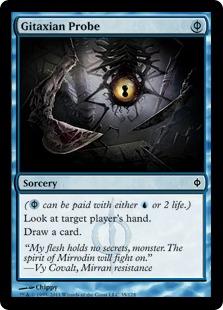 Normally reserved for Delver, Infect, delve-creature decks, and anyone still playing Storm, Gitaxian Probe helps you play a 56 card deck if you have the life total to maximize the sorcery. Fitting our article's theme, it's also a Legacy standout alongside the Modern-legal Pyromancer, and the Modern-illegal Cabal Therapy. Probe provides something none of the other free cards can offer, an invaluable resource that isn't always directly reflected on a board-state: information. Information to know what to counter and remove and what to ignore. Information to know when to commit and when to hold back. Information to know whether to play the Tarmogoyf or hold up the Goremand. A resolved Probe feels like cheating and with good reason. In a format as diverse as Modern, knowing an opposing deck is critical to getting wins, whether for an interactive strategy or a goldfish one figuring out when to pull the combo trigger.
Normally reserved for Delver, Infect, delve-creature decks, and anyone still playing Storm, Gitaxian Probe helps you play a 56 card deck if you have the life total to maximize the sorcery. Fitting our article's theme, it's also a Legacy standout alongside the Modern-legal Pyromancer, and the Modern-illegal Cabal Therapy. Probe provides something none of the other free cards can offer, an invaluable resource that isn't always directly reflected on a board-state: information. Information to know what to counter and remove and what to ignore. Information to know when to commit and when to hold back. Information to know whether to play the Tarmogoyf or hold up the Goremand. A resolved Probe feels like cheating and with good reason. In a format as diverse as Modern, knowing an opposing deck is critical to getting wins, whether for an interactive strategy or a goldfish one figuring out when to pull the combo trigger.
If your metagame isn't too Burn- and Gruul Zoo-heavy, Probe is a spectacular 1-2 card inclusion in your blue deck of choice. This is doubly true for Jeskai decks which must often decide whether to commit to turn four Nahiri or turn five Kiki-Jiki, Mirror Breaker. Probe also unlocks a secret cantrip mode on Snapcaster Mage, which ordinarily can't be deployed for value until turn three at earliest. Of course, Probe is even better in Games 2-3 when strange sideboard cards come in and you need to know what to play around. We may not have Therapy in Modern, but Probe's information is just as good here as in Legacy.
There are many other free spells worth considering in your Modern deck. Gut Shot is a personal favorite, as is the powerful delve fueler Mishra's Bauble. Whatever free spell you go with, take a leaf out of the Legacy playbook and look how you can use these unfair effects into your decks. They are often worth the slots.
Chalice of the Void
If you've played Legacy before, you're familiar with one of the fastest Game 1 losses in the format: on the play, turn one Ancient Tomb, Chalice of the Void at X=1, and pass. Game over, especially if you're one of those poor Delver decks packed with cantrips and one-drops waiting to topdeck an Angler. By no means do all Legacy decks fold to the Chalice play, a line reminiscent of Vintage for anyone familiar with Mishra's Workshop, but for those that do the experience is a brutal one.
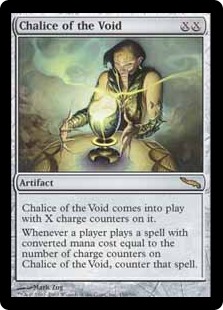 Chalice has been around in Modern for years, but it made its highest-tier debut during the nightmarish Pro Tour Oath of the Gatewatch, where a Simian Spirit Guide-powered Colorless Eldrazi monstrosity opened the floodgates for eldritch domination through April 4. The Eldrazi are gone, at least in their most warping form, and with them went the threat of a Tier 1 Chalice at X=1 on the play. Of course, Modern doesn't have the same one-drop quality of Legacy, which can make the turn one Chalice significantly less debilitating. Modern also has no City of Traitors or Ancient Tombs to regularly power out the Chalice, and the one-and-done Guide comes at significant card disadvantage costs. That said, Modern is still a format where one-drops can be critical to certain strategies, and that's where Chalice still has the potential to shine.
Chalice has been around in Modern for years, but it made its highest-tier debut during the nightmarish Pro Tour Oath of the Gatewatch, where a Simian Spirit Guide-powered Colorless Eldrazi monstrosity opened the floodgates for eldritch domination through April 4. The Eldrazi are gone, at least in their most warping form, and with them went the threat of a Tier 1 Chalice at X=1 on the play. Of course, Modern doesn't have the same one-drop quality of Legacy, which can make the turn one Chalice significantly less debilitating. Modern also has no City of Traitors or Ancient Tombs to regularly power out the Chalice, and the one-and-done Guide comes at significant card disadvantage costs. That said, Modern is still a format where one-drops can be critical to certain strategies, and that's where Chalice still has the potential to shine.
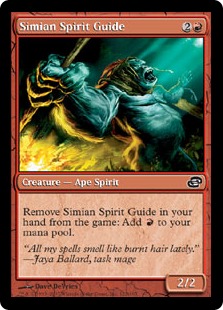 Taking Team Channel Fireball's Colorless Eldrazi as an example, we had a deck that could crush any midrange, control, or slower aggressive decks past turn three, but could also get outraced by Infect, Affinity, and Burn pilots looking to count to 10 or 20. Guide and Chalice addressed this specific weakness while not being irrelevant in other matchups. Here, it wasn't about Chalice shutting down a broad subset of the format, which is exactly what the X=0 Chalice might do in powered Vintage contests. Instead, Chalice/Guide plugged a particular aggro vulnerability while the rest of the deck handily crushed the remainder of the format.
Taking Team Channel Fireball's Colorless Eldrazi as an example, we had a deck that could crush any midrange, control, or slower aggressive decks past turn three, but could also get outraced by Infect, Affinity, and Burn pilots looking to count to 10 or 20. Guide and Chalice addressed this specific weakness while not being irrelevant in other matchups. Here, it wasn't about Chalice shutting down a broad subset of the format, which is exactly what the X=0 Chalice might do in powered Vintage contests. Instead, Chalice/Guide plugged a particular aggro vulnerability while the rest of the deck handily crushed the remainder of the format.
Eldrazi ultimately shifted towards UW, RG, and UR pairings, ditching Guide and Chalice in favor of something even more broken. Those decks have largely gone the way of the Eye of Ugin, but Chalice and Guide still remain as potent inclusions for any deck looking to shore up a bad aggro matchup. You can even pull the Dismember page from Colorless Eldrazi's playbook to keep access to an effective one-mana removal spell!
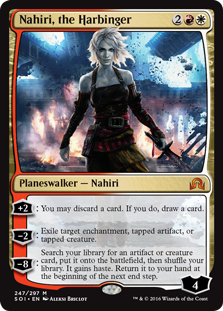 I'd love to see more midrange and prison decks use this combo as a catchall proactive solution to Modern's varied aggressive and linear strategies. As with Mardu and Pyromancer, I see this as another area where Nahiri can really help, hitting play a turn early via Guide on a cleared board and looting through excess Apes and artifacts after a lock is established. This doesn't need to be as prison-centric as John Pellman's notorious RW Lockdown deck from May's SCG Indianapolis Open, but Nahiri and Blood Moon could definitely deserve a home alongside the Guide and Chalice pairing.
I'd love to see more midrange and prison decks use this combo as a catchall proactive solution to Modern's varied aggressive and linear strategies. As with Mardu and Pyromancer, I see this as another area where Nahiri can really help, hitting play a turn early via Guide on a cleared board and looting through excess Apes and artifacts after a lock is established. This doesn't need to be as prison-centric as John Pellman's notorious RW Lockdown deck from May's SCG Indianapolis Open, but Nahiri and Blood Moon could definitely deserve a home alongside the Guide and Chalice pairing.
Modern may not have the Aerial Responders, Preordains, or Deathrite Shamans of Legacy, but it has plenty of decks that virtually or literally scoop to the X=1 Chalice on turn one. Hopefully we see more of this duo in the future, although given my unmentionable deck preferences lately, perhaps I should be polling against the Chalice.
Thanks for joining me on this romp through some key Legacy cards and concepts and how they might apply to Modern. What other cards do you think could make the jump? Any you are working with already or have interest in developing? Any big ones you think I missed? I'll catch you all in the comments and be back next week to talk about some card evaluation principles in the leadup to Eldritch Moon previews. Keep those fingers crossed for Innocent Blood and see you soon!





This is an interesting subject that I have pondered myself, Sheridan. I’ll give my opinions on the cards that you’ve mentioned, and then propose a couple of my own:
1. Young Pyromancer – I think you’re onto something with Jancuk’s list. Too many people fall in love with the Pyromancer-Probe interaction for immediate value, but without the Dazes and Forces to push your tempo gameplan while protecting the Pyro (plus the much greater suite of playable creature removal in Modern), I think it’s wise to treat the Pyro as a tool in the toolbox, and employ Mentors and Souls as additional ways to close things out. It’s pretty telling that the most successful Grixis Delver list in a while is Ryan’s list, which eschewed the Pyros altogether.
The question is whether this approach is better than trying to close out games with Nahiri + Emrakul, Kalitas, and maybe Pian and Kiran Nalaar, which is the other option available to Mardu decks. The tokens approach certainly plays nicer with Bob, but I’m unsure as to which measures up best overall. Thoughts?
2. Disrupting Shoal and Snapback are interesting, but I think the Shoal was the one who proved its worth the most in Jordan’s extensive testing with Delver shells. A small minority of Merfolk users have considered the Shoal and Snapback in that shell (since it meets the “must be blue-heavy” and the “must have a variety of CMCs” requirements), but we don’t have enough data to make conclusive judgments. I still think Shoal has potential in Merfolk (though it does push it in more of a tempo direction), but I don’t think Snapback does enough (especially because Shoal incentivizes you to run Snag for more blue 1-drops to pitch).
I think the case against Probe is that most proactive decks don’t care overly much about the information it provides (as in, it will not materially affect their decision trees), and you actually want the deck slots it’s taking up to have a greater diversity of threats. I think it could see more play, but with so many decks putting pressure on player’s life totals (I’ve even eschewed Dismember on my Merfolk in order to make sure that opponents have to deal me the full 20), I don’t know if a lot of people will reach for it.
3. Chalice of the Void – this card I feel is already in Modern, just around the fringes. It drifts in and out of Merfolk sideboards, and some big-mana decks that don’t have much going on in the early game (like Breach Titan/Titanshift) also run it in the sideboard. U-Tron runs some number of it in the main, but it usually has 3-4 copies in the 75.
I don’t think it’s strong enough to run in the main, though – Bogles scoops to it and Infect has a hell of a time overcoming it, but Modern Burn actually has enough 2-drops to survive it (especially if they snuck a creature or two in before the Chalice was cast), as does Grixis Delver (which even has 3+ drops to overcome a mid- to late-game Chalice for x=2). Furthermore, with cards such as Abrupt Decay, Ancient Grudge, and Destructive Revelry flying around, a Chalice on x=1 is no guarantee to stick around. I feel like only a select few decks really get the requisite juice out of it.
As for cards that I think could make the leap… I think Forked Bolt is somewhat under-utilized in Modern, as is Spell Pierce.
Disrupting Shoal in particular seems like it should see more play. There are only two mono blue decks I’ve found in learning about modern: control tron and merfolk. Tron already plays Spell Burst. Merfolk has a ton of 2 and 3 drops to remove to stop something after dropping a creature. Maybe I’m just nuts for thinking it has a shot in either.
As someone who has played mardu for a while now, I must say I have disliked the pyromancer and mentor tokens package. I do however love my deck, (no soulfires here, they are bad) and I think it has a lot of potential. It absolutely shuts down infect, delver, merfolk, eldrazi, and other slower aggro decks. On the same note, it is able to grind out decks like Jund and Grixis, with lingering souls, dark confidant etc. The only downside is a terrible control and non creature combo matchup. I have been running sin prodder, he does lots of work as opponents cannot risk taking too much damage or else face comming in range of a bolt or two. I have also replaced terminates with dreadbore due to the prevalence of nahiri based decks.
I’m going to plug my current list, which is a further developed version of Joe Jancuk’s list
4 Dark Confidant
3 Monastery Mentor
4 Young Pyromancer
2 Zealous Persecution
4 Lightning Bolt
3 Lightning Helix
2 Thoughtseize
4 Inquisition of Kozilek
3 Lingering Souls
2 Path to Exile
2 Blood Crypt
1 Godless Shrine
2 Sacred Foundry
3 Bloodstained Mire
3 Marsh Flats
2 Arid Mesa
1 Vault of the Archangel
2 Plains
2 Swamp
1 Mountain
2 Kolaghan’s Command
2 Blackcleave Cliffs
1 Needle Spires
2 Painful Truths
1 Slaughter Pact
1 Shambling Vent
1 Dreadbore
SB: 1 Purphoros, God of the Forge
SB: 2 Kor Firewalker
SB: 2 Crackling Doom
SB: 2 Stony Silence
SB: 1 Obzedat, Ghost Council
SB: 1 Rakdos Charm
SB: 1 Relic of Progenitus
SB: 1 Slaughter Games
SB: 1 Rest in Peace
SB: 2 Celestial Purge
SB: 1 Molten Rain
Obviously, local meta tuning may apply.
Overall matchup comments:
Affinity and Infect are highly favored, they really don’t like the combination of 1/1 spam and heavy access to removal
Tron and other big mana matchups are heavily unfavored. You’re weak to sweepers and aren’t fast enough to kill them before they get online.
Jund, UWR, and other midrange/control matchups are usually sideboard dependent on if they remembered to pack x/1 hate. The more people cut electrolyzes and sweepers the better this list gets, but if your meta is chock full of Night of Soul’s Betrayal you’re going to be in for a world of hurt
Company is generally favored, you have enough removal and can grind hard. Just be sure to play around Chord for Orzhov Pontiff with my favorite Zealous Persecution or other options.
As for other tier 2 decks, Merfolk is miserable as their land disruption punishes our heavy color commitments, Ad Naus is also problematic as we’re too slow to race them and rely on hand disruption and Kommand to stop them from going off, plus don’t have any answers to Phyrexian Unlife other than just killing them. Most other tier 2 decks fall into the above assessments about aggro/midrange/big mana. Only note I’ll make is I’ve found Eldrazi and Taxes favored because they really don’t like seeing 7 copies of 3 damage to target creature.
Not necessarily a “GP breakout,” but Shoal did make Top 8 of GP Singapore last year in a Monkey Grow deck: http://magic.wizards.com/en/events/coverage/gpsin15/top-8-decklists-2015-06-28
There was a grixis thopter foundry deck that 5-0ed a modern league a couple weeks ago.
Hardly a breakout performance, but it did run a full playset of YP alongside snap, tasigur, and of Keral Keep.
Looked pretty interesting.
But maybe that’s just because I’m not willing to let go of my cantrips